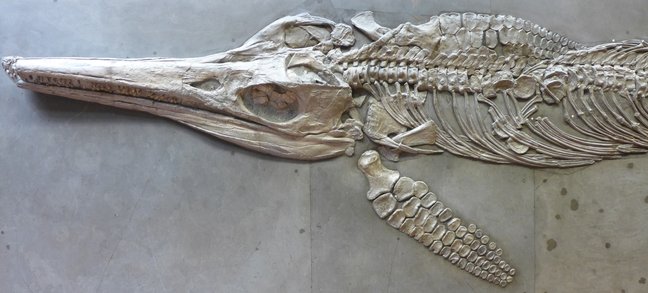Stuttgart, 03.11.2023. Marine reptiles were among the most important components of oceanic ecosystems during the age of the dinosaurs. Some of them were predators at the top of the food chain, like the ichthyosaur Temnodontosaurus. In a new study, an international team of researchers, including marine reptile specialist Dr. Erin Maxwell of the State Museum of Natural History Stuttgart, has examined the fossilized teeth of Temnodontosaurus in more detail. This ichthyosaur could grow up to ten meters long and also lived in Germany during the early Jurassic period about 180 million years ago. The team was able to demonstrate different tooth shapes in the various species of this genus, which speaks to a significantly stronger specialization in feeding than was previously assumed for such large predators of this group. The results show how the diet and hunting strategy of large predators in marine ecosystems have changed over time. The study was published in the “Journal of Anatomy”.
Modern technologies help to study the ecology of animals
Direct observation of the way of life of extinct animals is not possible and many groups, including ichthyosaurs, that have no relatives living today. Therefore in paleontology fossils such as teeth and dentitions, are examined in order to be able to make indirect statements about the way of life of the various prehistoric animals. When analyzing the teeth and skulls of the ichthyosaur Temnodontosaurus, the researchers were helped by the use of cutting-edge technologies such as 3D scans and imaging techniques with the scanning electron microscope. The teeth of top predators like Temnodontosaurus have to perform different tasks, including holding prey and cutting meat. Depending on the type of prey, they need specialized teeth to do this. The different tooth shapes of Temnodontosaurus show that even animals far up the food chain sometimes prefer a very specific prey or hunting method.
Teeth provide important clues about lifestyle and diet
"Fossil teeth play a major role in reconstructing the diet and ecology of extinct animals. The different tooth shapes and skull adaptations among Temnodontosaurus species suggest that prey was caught and eaten in different ways. The range of adaptations is an important indication of how these individual species coexisted by partitioning ecological niches. This allowed the animals to avoid competition with each other and with other ichthyosaurs of the time," said Dr. Erin Maxwell. The studies allow researchers to understand how the role of large predators in marine ecosystems has changed over time. Temnodontosaurus ate other ichthyosaurs, squid and fish.
Ichthyosaurs, denizens of the Jurassic Sea
Ichthyosaurs emerged in the Triassic period about 250 million years ago following the largest mass extinction event in Earth's history. Within only a few million years, they reached body sizes comparable to those of today's whales. After the Triassic period, the species diversity of ichthyosaurs decreased and they rarely reached lengths of more than five meters. An exception is Temnodontosaurus, which was one of the top predators of European seas in the Jurassic. Currently, there are about seven described species of Temnodontosaurus, which differ in certain characteristics including tooth shape. The paleontological collection of the State Museum of Natural History Stuttgart houses several, partially complete skeletons of Temnodontosaurus, which were examined as part of the new study.
For the editors
Original publication:
Bennion, R. F., Maxwell, E. E., Lambert, O., and Fischer, V. (2023). Craniodental ecomorphology of he large Jurassic ichthyosaurian Temnodontosaurus. Journal of Anatomy 00, 1-20.
DOI: https://doi.org/10.1111/joa.13939
Published: 08/17/2023
Image material:
Picture 1: Picture1_Skull and teeth of Temnodontosaurus, SMNS R Bennion.jpg
Description: skull and teeth of Temnodontosaurus. The ichthyosaur shows a number of different adaptations of the skull and teeth to capture prey, including different tooth shapes in the jaw and serrated cutting edges visible in the scanning electron microscope.
Copyright notice: R. Bennion, SMNS
Picture 2: Picture2_Temnodontosaurus_Collection SMNS, SMNS, M.Rech.jpg
Description: The fossil of a Temnodontosaurus in the collections of the Stuttgart Museum of Natural History. The fossil is from the Posidonia Shale and is about 182 million years old.
Copyright notice: SMNS, M. Rech
Please note that the use of the photographic material is only permitted if the copyright is acknowledged. Thank you.
Contact:
Dr. Erin Maxwell
State Museum of Natural History Stuttgart
Department of Paleontology
Tel. 0711 - 89 36 - 145
E-Mail: erin.maxwell(at)smns-bw.de
Press contact:
Meike Rech
State Museum of Natural History Stuttgart
Tel. 0711 - 89 36 - 107
E-Mail: meike.rech(at)smns-bw.de
The State Museum of Natural History Stuttgart:
The Stuttgart Museum of Natural History is a forward-looking research and communication institute. Its research collections, the archives of diversity, contain over 12 million objects. The museum researches the evolution of life and analyzes the biodiversity of different ecosystems and communicates research findings to the general public. It is also strongly committed to training the next generation of young scientists.
